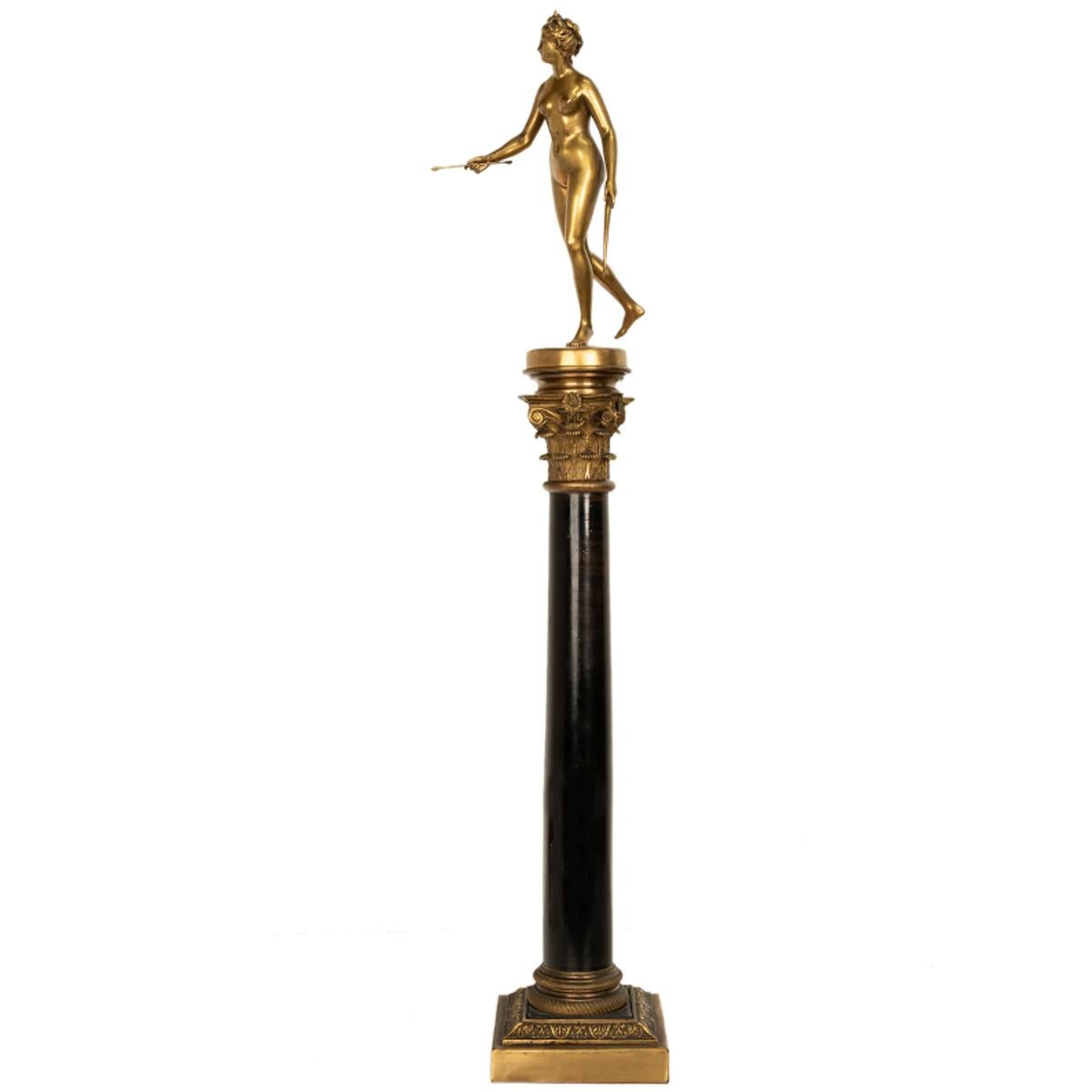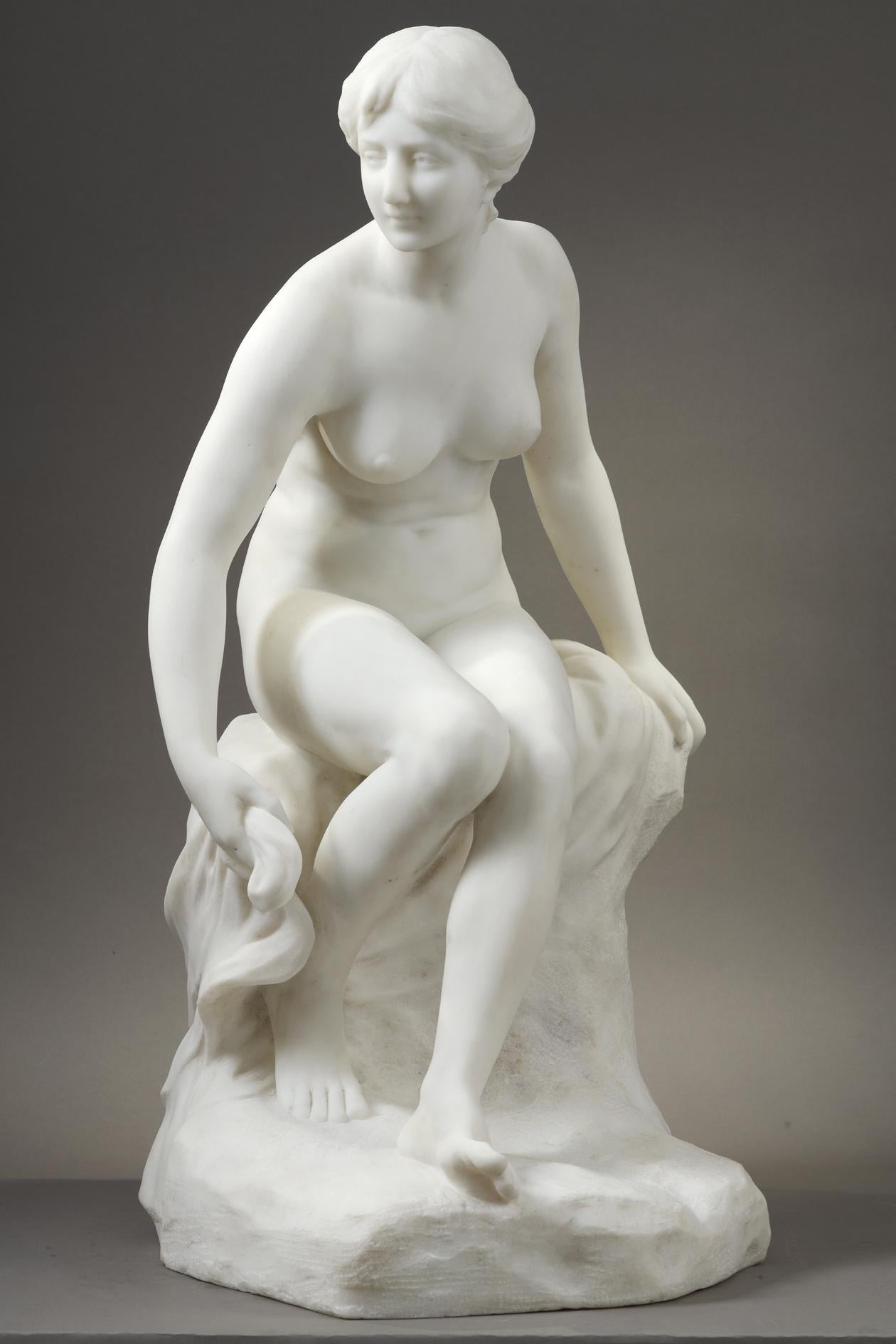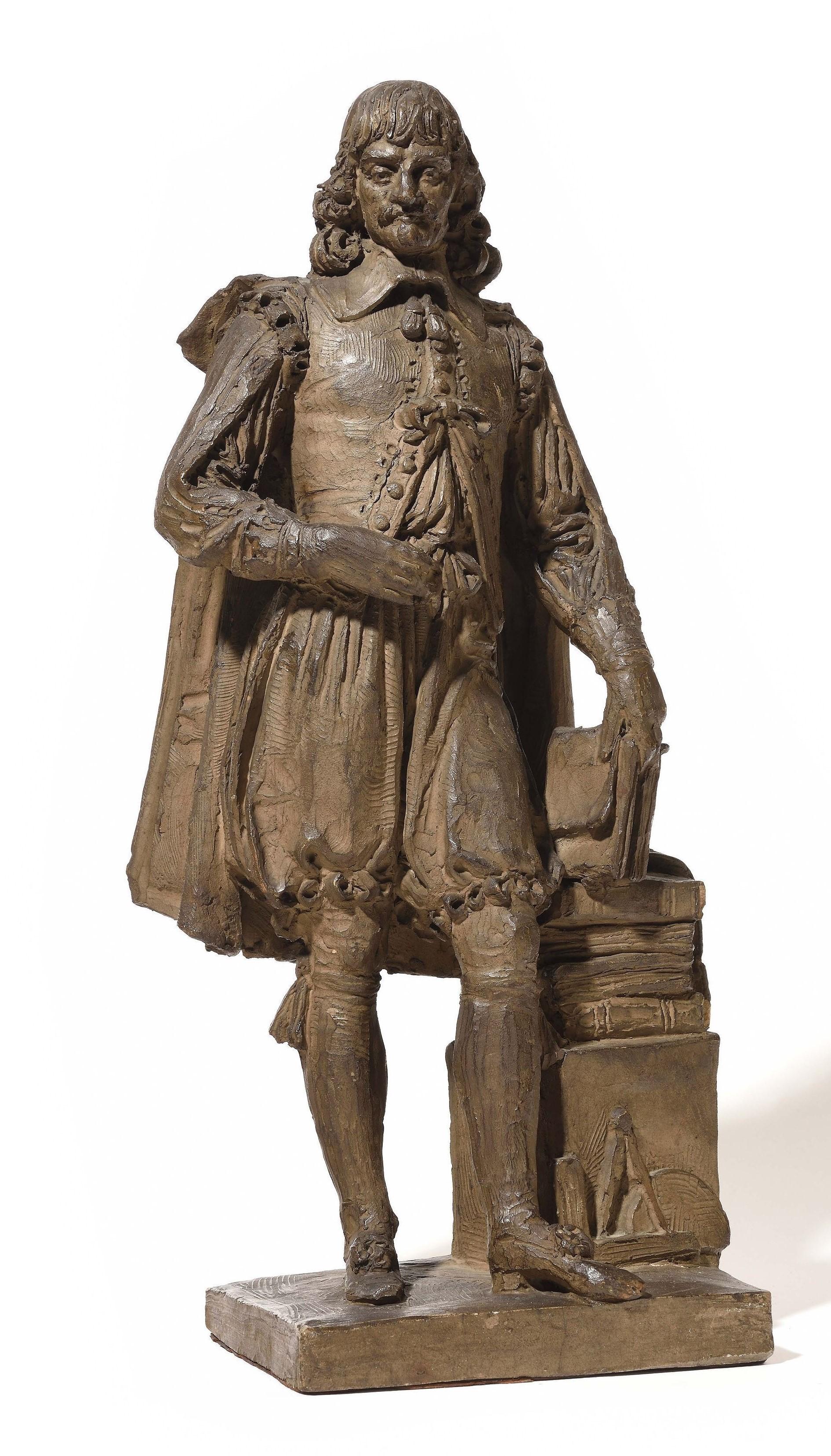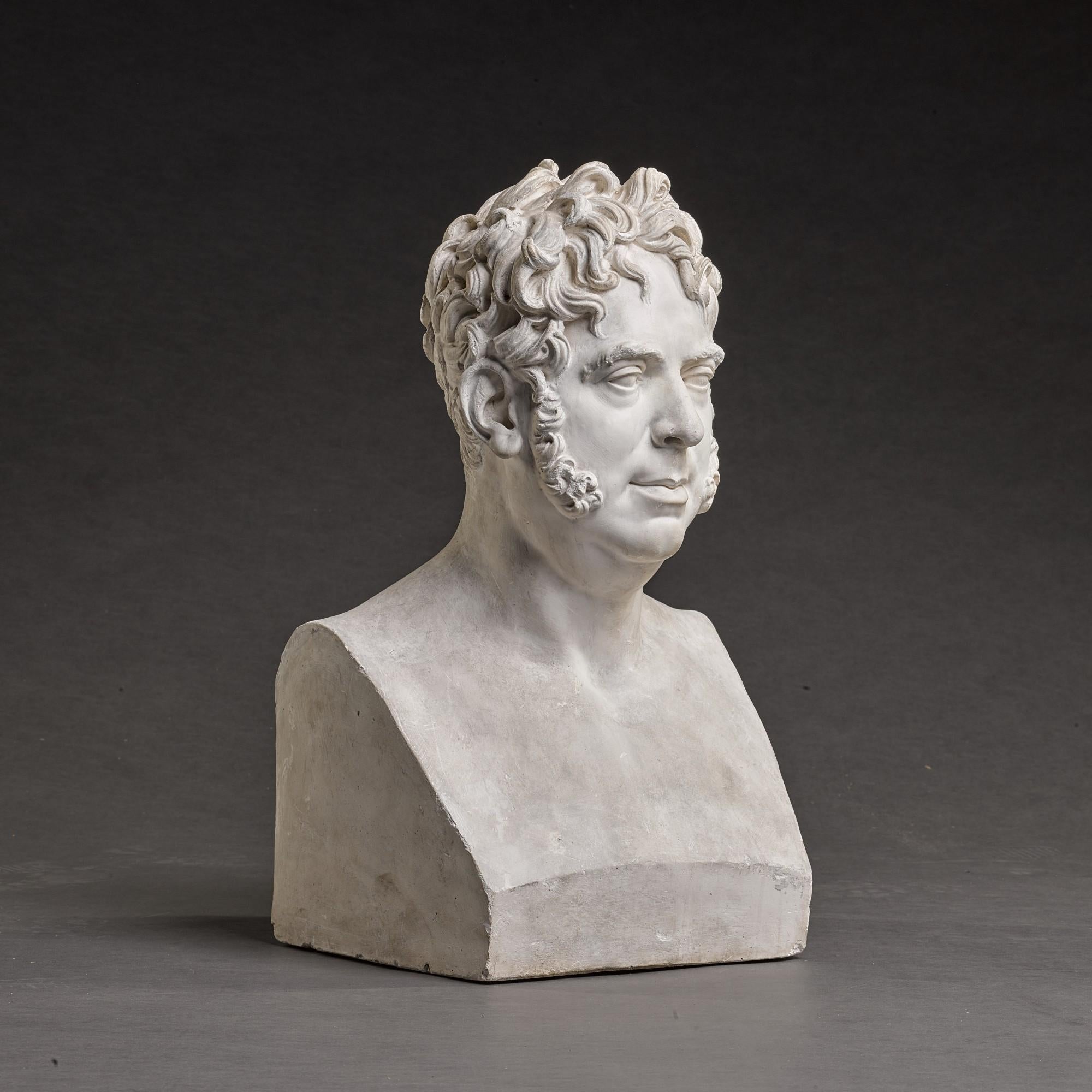Items Similar to Napoleon Ist
Video Loading
Want more images or videos?
Request additional images or videos from the seller
1 of 8
Napoleon Ist1808
1808
About the Item
Antoine-Denis CHAUDET (1763 - 1810)
NAPOLEON Ist, circa 1808
Carrare Marble - First Empire
Hermes Bust of Napoleon Ist, after Antoine-Denis CHAUDET
Dimensions : 23 5/8 x 12 x 10 1/4 inches
(Dimensions : 60 x 33 x 26 cm)
Antoine Denis Chaudet, born March 3, 1763 in Paris and died in the same city on April 19, 1810, was a French neoclassical sculptor and painter.
A pupil of Jean-Baptiste Stouf and Étienne Gois senior, Chaudet won a first Prix de Rome of sculpture in 1784 on the subject of ‘Joseph sold by his brothers’, and left for the French Academy in Rome. He will stay there for four years. On his return, in 1789, he was admitted to the Royal Academy of Painting and Sculpture. In 1805, he was made a member of the Institute. He was appointed professor at the Ecole des Beaux-Arts in Paris on February 1, 1810, replacing Louis-Jean-François Lagrenée the Elder and will be succeeded by François-Frédéric Lemot on September 8, 18102.
Its statue of Napoleon Ist as imperator erected in 1810 in Paris and crowning the column of the Grande Armée, place Vendôme will be replaced in 1863 by a figure of Auguste Dumont.
Museums:
- Amiens, Musée de Picardie: bustes de Napoléon Ier
- Château de Compiègne: Statue de Napoléon Bonaparte, 1804, marbre; Portrait de Napoléon Ier, 1811, buste
- Lille, Palais des Beaux-Arts: Le Repos de Bélisaire aveugle, 1791
- Paris: Fontaine des Invalides, Mascarons, 1804.
Musée du Louvre: Œdipe enfant rappelé à la vie par le berger Phorbas qui l'a détaché de l'arbre, 1801, groupe en marbre; L'Amour ramassant un papillon, Salon de 1817, statue en marbre terminée par Pierre Cartellier d'après un modèle en plâtre de 1802; La Paix, 1806-1807, statue en argent et en bronze doré; Œdipe et Phorbas; buste en marbre; Buste de l'architecte Julien-David Le Roy.
Panthéon de Paris, péristyle: L'Émulation de la gloire, 1801, groupe en pierre.
Château de Versailles, galerie des Batailles: Jacques François Dugommier, buste.
Vizille, musée de la Révolution française: Buste du consul romain Lucius Junius Brutus.
- Creation Year:1808
- Dimensions:Height: 23.63 in (60 cm)Width: 13 in (33 cm)Depth: 10.24 in (26 cm)
- Medium:
- Movement & Style:
- After:CHAUDET Antoine-Denis (1763 - 1810, French)
- Period:
- Condition:
- Gallery Location:Paris, FR
- Reference Number:
About the Seller
5.0
Recognized Seller
These prestigious sellers are industry leaders and represent the highest echelon for item quality and design.
Established in 1969
1stDibs seller since 2017
16 sales on 1stDibs
Typical response time: 1 hour
- ShippingRetrieving quote...Ships From: Paris, France
- Return PolicyThis item cannot be returned.
More From This SellerView All
- L'AiglonBy Louis OuryLocated in Paris, FRLouis Oury (1867 - 1940) L’Aiglon, 1899 Terracotta with polychromatic patina Signed on the shoulder and Seal from Goldscheider on the reverse Dimensions : 65 x 40 x 30 cm (25 x 15 3/...Category
19th Century French School Figurative Sculptures
MaterialsTerracotta
- Lion HeadBy Bernard & Arnaud BessoudLocated in Paris, FRBernard & Arnaud Bessoud, 1946 & 1971 French "Lion Head", Bronze with brown patina Foundry Chapon Signed on the base and numbered 14/30 Certificate from t...Category
20th Century Figurative Sculptures
MaterialsBronze
- Saint Michel et le DragonBy Emmanuel FremietLocated in Paris, FREmmanuel Fremiet, 1824-1910 French Saint-Michel et le Dragon Signed “E. Fremiet”, Barbedienne Foundry 23 5/8" high x 5 1/2" wide FREMIET Emmanuel: ...Category
19th Century Figurative Sculptures
MaterialsBronze
- Last Days of Napoleon in St-HelenaLocated in Paris, FRVincenzo VELA (1820-1891) Last Days of Napoleon in St-Helena Created in 1866 Bronze with brown patina Signed ‘V. Vela F. 1867’ on the terrace. Signed ‘F. Barbedienne Fondeur’. Stamp ...Category
1860s Realist Figurative Sculptures
MaterialsBronze
- Le General Bonaparte en EgypteBy Henri Alfred Marie JacquemartLocated in Paris, FRAlfred Jacquemart 1824-1896 Le General Bonaparte en Egypte Bronze, Barbedienne Foundry 10 1/4" high x 8" wide x 4" depth Henry Alfred Jacquemart (1824-1896): born the February 22,...Category
Mid-19th Century Figurative Sculptures
MaterialsBronze
- Vive l'EmpereurBy Charles Edouard RichefeuLocated in Paris, FRCharles Edouard Richefeu 1868-1945 French Vive l'Empereur Bronze, Susse Fondeur in Paris Signed on the base, on the right side 39 1/2" high and approximatively 21 1/4" wide x 21...Category
Late 19th Century Figurative Sculptures
MaterialsBronze
You May Also Like
- Antique French Grand Tour Gilt Bronze Statue on Column Diana the Huntress 1838By Ferdinand BarbedienneLocated in Portland, ORA fine & large (34" tall) antique French gilt-bronze on marble column of Diana, cast by Ferdinand Barbedienne (1810-1892) after a statue by Jean Antoine Houdon (1741-1828), the bronz...Category
1830s French School Figurative Sculptures
MaterialsMarble, Bronze
- BatherLocated in PARIS, FRBather by Etienne Hachenburger (19th-20th C.) Sculpture in white Carrara marble Signed on the side of the base "E. Hachenburger" A simiilar model was exhibited at the Paris Salon oh...Category
Early 1900s French School Nude Sculptures
MaterialsMarble
- The SpringBy Albert-Ernest Carrier-BelleuseLocated in PARIS, FRThe Spring by Albert-Ernest CARRIER-BELLEUSE (1824-1887) Sculpture made in white Carrara marble signed on the base "A. Carrier-Belleuse" France circa 1870 height 76,5 cm width 30 cm depth 24 cm Biography : Albert-Ernest Carrier de Belleuse known as Carrier-Belleuse (1824-1887) was one of the most prolific artists of the century and had the greatest successes under the Second Empire, enjoying the personal support of Napoleon III. His work was greatly influenced by the style of the Italian Renaissance and that of the 18th century, which he helped to bring up to date. In 1837, the young Carrier-Belleuse apprenticed in the workshop of the engraver Bauchery. He was admitted soon after to the goldsmith Jacques Henri Fauconnier. Through François Arago, he met the sculptor David d'Angers who facilitated his admission to the School of Fine Arts. Carrier-Belleuse entered it in 1840. Noted for his skill by the great bronze companies in Paris such as Barbedienne and Denière, he soon received numerous orders for models for candelabras, pendulums, fittings for fireplaces, etc. In 1848, probably at the initiative of François Arago, who became head of state, he received his first public order for a small statue of "Mademoiselle Rachel singing La Marseillaise". In 1851, he appeared for the first time at the Salon of French Artists, where he presented two bronze medallions. From 1851 to 1855, Carrier-Belleuse stayed in England, in Stoke-on-Trent where he served as director of the modeling and drawing school of the Minton house, a large porcelain manufacturer. Back in France, Carrier-Belleuse moved to Paris in a large workshop located 15 rue de la Tour d´Auvergne. From 1857, he made regular sendings to the Salon and became famous thanks to the success of large marbles, such as the "Bacchante" exhibited at the Salon in 1863, and acquired by Napoleon III, "Angelica" (1866) or even "Hebe asleep" (1869). At the Salon of 1867, his group entitled "Messiah" earned him the medal of honor of sculpture. It was acquired by the State to adorn the Chapel of the Virgin in the Saint-Vincent-de-Paul church. Carrier-Belleuse acquired a great reputation in parallel for his terracotta busts which, in many respects, recall those of 18th century artists. He made portraits of a large number of celebrities of his time. He produced, among others, the busts of Napoleon III, Renan, Thiers, Grévy, Arago, Marguerite Bellanger, Théophile Gautier, Honoré Daumier, Delacroix, Hortense Schneider, Réjane… He also modelled numerous busts of mythological inspiration and historical and artistic portraits like Marie Stuart, Shakespeare or even Mozart. Carrier-Belleuse used and trained in his workshop in the rue de la Tour d´Auvergne many young talented artists such as Alexandre Falguière, Jules Desbois, Eugène Delaplanche, Jules Dalou or Joseph Chéret; but he was best known for having been the master of Auguste Rodin who entered his studio as a practitioner in 1864. Carrier-Belleuse devoted himself a lot to decorative sculpture. He contributed to the decorations of many important buildings. We owe him in particular the caryatids of the Renaissance theater in Paris, the pediment of the main entrance to the Banque de France, the stucco ceilings of the Lesdiguières and La Trémoïlle pavilions at the Louvre Palace, the frieze of the Palais de la Bourse in Brussels, or the decoration of the Hôtel de la Païva on the Champs-Elysées in Paris. He also received State commissions for monuments: that of Jean-Jacques Rousseau in Montmorency, of Alexandre Dumas, in Villers-Cotterêts, of Masséna in Nice. Abroad, he produced the equestrian statue of Michael the brave in Bucharest and the tomb of José de San Martín in Buenos Aires. In 1873, Carrier-Belleuse took part in the construction of the Paris Opera house, directed by his friend Charles Garnier. He created the two monumental torchieres...Category
1870s French School Figurative Sculptures
MaterialsMarble
- Dominique Mahlknecht (1793-1876) The french philosopher René DescartesLocated in BELEYMAS, FRDominique (Johann Dominik) MAHLKNECHT (Kastelruth, 1793 - Paris, 1876) Full length portrait of René Descartes Terracotta with brown patina Height: 40cm ...Category
1840s French School Figurative Sculptures
MaterialsPlaster
- General Cambronne bust in "Hermès" - Att. to E-E Suc (1802-1855)Located in BELEYMAS, FRAttributed to Etienne-Édouard SUC (Lorient, 1802 – Nantes, 1855) Bust "in Hermès" of General Cambronne Plaster H. 59 cm 1842 Provenance: probably Madame Cambronne (1773-1854), widow...Category
1840s French School Figurative Sculptures
MaterialsPlaster
- Hay PickerBy Aimé-Jules DalouLocated in PARIS, FRThis Peasant resting is a subject that is included in the famous suite commonly called "little workers" by Jules Dalou (1838-1902) Bronze with nuanced dark brown patina cast by Susse Frères - stamped with the founder's seal France created around 1890 and cast after his death height 12,5 cm A similar model reproduced inJules Dalou, le sculpteur de la République, Exhibition held at the Musée du Petit Palais, Paris, 2013, page 288, n°220. Biography : Aimé-Jules Dalou, said Jules Dalou (1838-1902) was a French sculptor, born from Protestants glovers craftsmen who raised in secularism and love of the Republic. Jules Dalou was very young talented for modeling and drawing, which earned him the attention of Jean-Baptiste Carpeaux, who made him entered in 1852 in the Little School, the future National School of Decorative Arts in Paris. In 1854, he was admitted to the School of Fine Arts in Paris, where he studied painting in the workshop of Abel de Pujol and sculpture in the workshop of Francisque Duret...Category
Late 19th Century French School Figurative Sculptures
MaterialsBronze
Recently Viewed
View AllMore Ways To Browse
Napoleon The 3
French Art 1800
Bronze Napoleon Sculpture
Napoleon Figure
Bronze Sculpture Of Napoleon
Napoleon French Bronze Sculpture
Portrait Of Napoleon
French Bronze Sculptures Of Napoleon
Chateau De Versailles
Statues Rome Antique
Statue Rome Antique
Hermes Paris 12
Antique Marble Statue Art Sculptures
Hermes 3d
Napoleon Bust
Bust Of Napoleon
Hermes Sculpture
French Empire Salon



